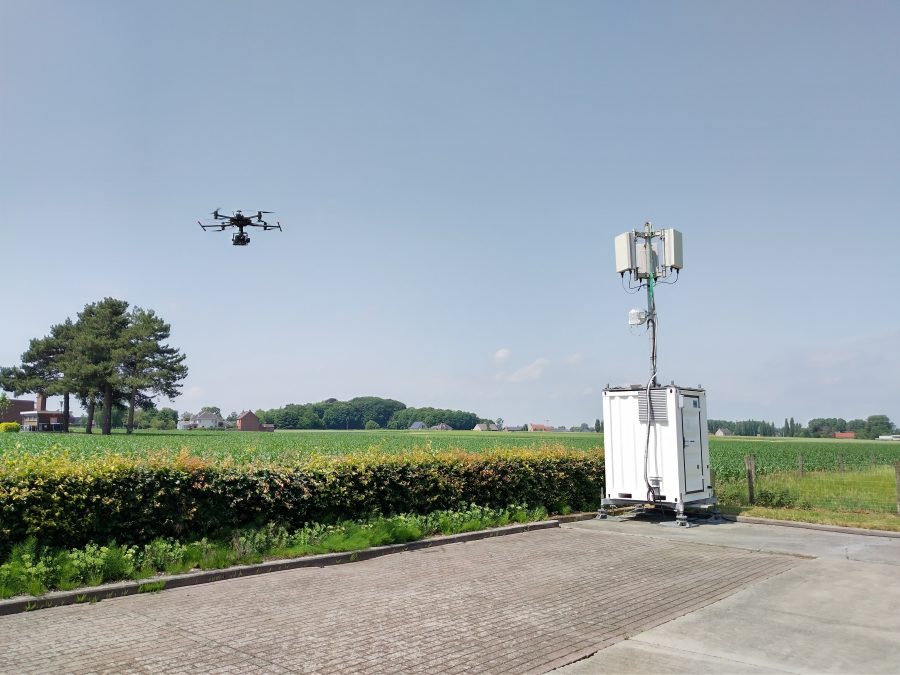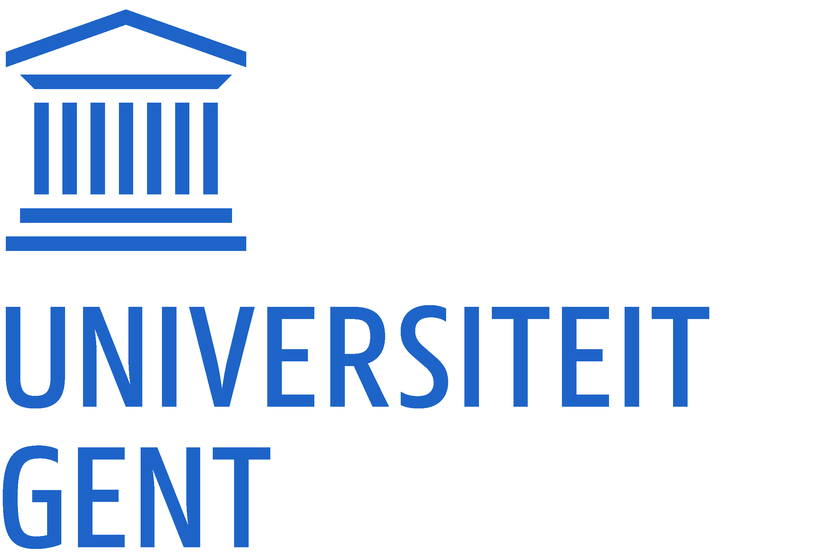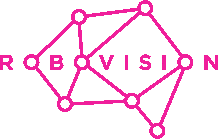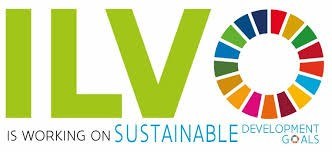Press release Through 5G and A.I. to real-time site-specific weed control. Up to 80% less herbicides? Same agricultural yield!
Early summer 2021. A pilotless drone flies over a Belgian maize field next to a 5G tower. This is the world's first demonstration of a special chain of innovative technologies that promises dramatically more sustainable weed control. A high-tech camera mounted on the drone transmitted images of the field in real time via the 5G antenna to the cloud. Trained algorithms (artificial intelligence) immediately detected the location of the weeds in the field and converted that information into a digital spraying map for a smart sprayer fitted with individually adjustable nozzles. In real time, the job map was transmitted to the tractor via the cloud which immediately started its (GPS-controlled) spraying job. Only the areas with weeds were treated while the rest of the field was left untouched. The result: 80% less herbicide use and the same agricultural yield.
This demo is part of the SmartAgriHub Flagship Innovation Experiment 'AI4Agriculture', involving 8 partners.

Flemish Minister of Agriculture and Innovation Hilde Crevits: "What we see here is a technological tour de force. Using artificial intelligence, fast mobile data transmission, autonomous drones and cameras, data is collected and a task can be given to a tractor. In this way, we can take enormous steps towards protecting our crops in a sustainable way, which is after all an important Flemish and European agricultural ambition. Based on these technological experiments, we can also think about other applications in the agricultural sector. Conversely, this is a good opportunity for technologists to get to know the technical side of the agricultural sector better and to strengthen each other."
AI and 5G part of the answer to a challenge
More sustainable agriculture and food production is characterized by:
- equal (or higher) yield (output) obtained
- using (much) less input (fertilizer, crop protection, energy),
- on an acceptable amount of agricultural land (space)
- without depleting natural resources (soil, air, water)
Europe is advocating this ambition in its Green Deal and its Farm to Fork strategy: for example, it envisages an agricultural production of the same quality as today, but with a significant reduction in the use of plant protection products (by half!).
According to researchers and farmers, technological, data-driven answers under the heading of 'precision farming' ('smart farming') will enable progress to be made towards this objective. Instead of applying plant protection products across the entire field, precision agriculture aims to work in an uneven and targeted manner: only apply a product/treatment or fertilizer where it is needed, and then in the right quantity, at the right time and at a feasible cost.
Joris Relaes, Administrator General ILVO: "This is an eco-modern approach, which we expect could find useful applications in all farming systems and scale types. The AI4Agriculture innovation experiment demonstrates how in weed management we can achieve an even better balance between the inputs and outputs of our food production, and between economy and ecology."
Chain of technology and communication with very specific areas of expertise
Goal: weed management

Prof. Benny De Cauwer (UGent, Faculty of Bio-engineering sciences, Department of Plants and Crops)
In our agriculture and horticulture you see a wide variety of crops and conditions, and weed science (the study of weeds and how to control them) is also very complex. Using only the naked eye, a specialist can distinguish crops and weeds, determine plants down to the species level, quantify field occupancy, and then design and implement management measures. It's another story to teach that skill to a machine. To accurately discern what is a weed, especially if it is a lookalike of the production crop, at an early and therefore manageable growth stage, then to decide which action to take (remove, suppress, tolerate), and then to implement those measures at the specific site and precisely at an appropriate time, as soon as possible after detection...that's a big challenge which requires a combination of a lot of complex expertises. But it is an interesting additional tool in the toolbox for sustainable weed management.
Pilotless drones collect and send data in real time using 5G

Constantijn Vermeer, Exobotic
Pilotless drones are the "next generation" in this agricultural experiment, compared to pilot-controlled, traditional drones. Automation not only provides cost savings (labor), but also better data. Specifically, the drone in this demo takes off from its ground station after a remote command, collects image data with its miniature camera, immediately transfers that data to the cloud via 5G in the desired form, and at the end of its flight path, places itself back in the ground station to recharge. Both for data collection, data transmission and analysis, 5G is deployed in combination with A.I. This combination not only allows everything to be done in real time, it also enables more complex underlying calculations because you are not limited to a "light" and "small" computer on the drone itself. The link to the cloud via 5G enables dreams of multifunctional, autonomous drones and robots that collect and analyze data in the field and immediately link actions to it.
Image sensors, miniaturization, multi-purpose spectral possibilities

Kris van de Voorde, Imec specialist in image sensor development
Miniaturized hyperspectral cameras combine imaging and spectroscopy in both the visible to the short-wave infrared (SWIR) domain, allowing these cameras to observe more than classical RGB (Red-Green-Blue) or SWIR cameras. This makes it possible to accurately image certain plant characteristics (drought stress, disease...) in numerous new scenarios, also outside the lab, in a cost-effective way. The possibilities of these special cameras, where a hyperspectral filter is applied to the (visible light or infrared sensitive) image sensor, are being extensively tested by imec and partners. The question of which plants or other pest organisms on a crop show which reflection at which bandwidth is a knowledge domain to be mined that is of great importance for the subsequent A.I. processing. Other factors such as camera weight, power consumption, data processing, data connectivity, etc. also play an important role in the development of a fully functioning system for agricultural applications.
A.I.: How deep learning software learns to recognize weeds in images

Jonathan Berte, CEO Robovision
Robovision is a Flemish A.I. company that solves image processing cases for robotics and machine builders in a scalable way. The high-performance A.I. algorithms created and managed in the Robovision A.I. platform interpret drone images and distinguish between the crop, the weeds and the soil under in strongly varying environments. On both a sunny and cloudy day, the A.I. model can detect different types of weeds in a field, at different densities, on different soil types and at different crop stages. Agriculture is a complex environment due to the variability in natural processes. But thanks to the extensive data set and fine-tuning of the model parameters, a very robust A.I. model was created that provides task maps based on which intelligent agro-machines can take very precise action. The next step to make the A.I. model even more interesting is to learn to discriminate between the different types of weeds and their density in the field. In this way it can specifically detect toxic or persistent weeds that definitely need to be treated, and "ignore" harmless weeds that do not need to be treated in the task map.
5G: gigabit speed, priority availability, 10x less energy use

Geert Standaert, Chief Technology Officer van Proximus
Building a robust, reliable and energy-efficient gigabit network for Belgium, via fiber and 5G, is central to our business strategy. As this demonstration shows, 5G is paving the way for innovative applications in a wide range of sectors, which will allow companies to become more efficient and can help make our society more sustainable. Our open 5G innovation platform aims to stimulate the development of these new applications in close cooperation with industry. In this way, 5G as a technology will be a real game-changer for the way we organize our economy and society in the future.
Building bridges, co-creative innovation, focus on practical implementation

Jurgen Vangeyte, Scientific Director of Agricultural Engineering at ILVO
In this kind of technological innovation trajectory, ILVO is a partner that understands the language, the potential and the limitations of all expertises, and builds bridges. We have knowledge of plants, crop protection, soil management, agricultural practices, agrotechnology, data (communication) technology, drone and robot technology, A.I., and even business models for innovations. That the potential of A.I. and 5G with drones is effectively demonstrated in an agricultural practice is exceptional and important. The farmer as the end-user of this technology must believe in this possibility, and that means seeing it in action first. In the Living Lab Agri-food Technology we develop and demonstrate as many innovations as possible in a practical environment, with the end user present. Ultimately, this often leads to the development of a dashboard or management tool that farmer can use on-farm.
Embracing and supporting technological solutions

Kristof Severijns, Innovation Support consultant for Boerenbond
Innovation Support at Boerenbond supports farmers to better respond to a rapidly changing market and society using innovation. We challenge them to look at the world with a healthy dose of discernment, and to discover how they can contribute to sustainable food production through innovation.



